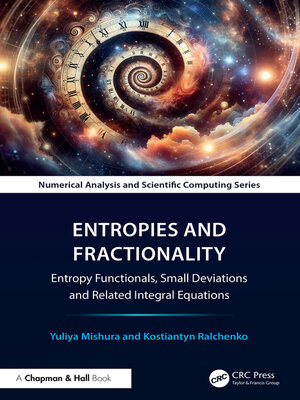Entropies and Fractionality
ebook ∣ Entropy Functionals, Small Deviations and Related Integral Equations · Chapman & Hall/CRC Numerical Analysis and Scientific Computing Series
By Yuliya Mishura

Sign up to save your library
With an OverDrive account, you can save your favorite libraries for at-a-glance information about availability. Find out more about OverDrive accounts.
Find this title in Libby, the library reading app by OverDrive.



Search for a digital library with this title
Title found at these libraries:
| Library Name | Distance |
|---|---|
| Loading... |
Entropies and Fractionality: Entropy Functionals, Small Deviations and Related Integral Equations starts with a systematization and calculation of various entropies (Shannon, Rényi, and some others) of selected absolutely continuous probability distributions. The properties of the entropies are analyzed. Subsequently, a related problem is addressed: the computation and investigation of the properties of the entropic risk measure, Entropic Value-at-Risk (EVaR).
Next, the book computes and compares entropy values for the one-dimensional distributions of various fractional Gaussian processes. Special attention is then given to fractional Gaussian noise, where the authors conduct a detailed analysis of the properties and asymptotic behavior of Shannon entropy. Additionally, two alternative entropy functionals are introduced which are more suitable for analytical investigation.
Furthermore, relative entropy functionals for the sum of two independent Wiener processes with drift are considered, and their minimization and maximization are explored. A similar problem is addressed for a mixed fractional Brownian motion (i.e., the sum of a Wiener process and a fractional Brownian motion) with drift. The entropy minimization problem is reduced to a Fredholm integral equation of the second kind, and its unique solvability is thoroughly investigated.
In the final part of the book, the optimization of small deviations for mixed fractional Brownian motion with trend is studied. This problem is closely related to the minimization of relative entropy functionals and is solved using similar techniques and results, which leads to the same class of integral equations. Since solving such equations is challenging due to the presence of an additional singularity in the kernel, efficient numerical methods have been developed to address this difficulty.
Features







